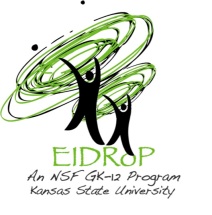Teaching Experience
Instructor, Division of Biology, Kansas State University
BIOL198: Principles of Biology; 80 students; Fall 2013
I currently teach the introductory biology class at Kansas State University. This class is not taught in the traditional lecture-lab format, but in the integrated studio format. In this format a short lecture introduces the topic of the day. The students then work in groups on wet labs, computer exercises, and other active exercise. A short wrap-up is used to emphasize the key points of the class. Frequent quizzes and tests provide quick feedback to the students. Working in a team with two faculty instructors and one other graduate teaching assistant, I was responsible for lead-teaching one topic, while assisting with all other topics. Topics include evolution, ecology, cell biology, genetics, energetics, plant biology, and animal biology.
NSF Graduate STEM Fellow in K-12 Education (GK-12) 
Junction City High School, Junction City, KS Fall 2012- Spring 2013
- Collaborated with a partner teacher to bring current research into diverse high school classrooms
- Developed and lead modules on seed ecology, climate change, and scientific communication for Field Biology and Meteorology courses
- ~10 hours per week total classroom, training, and preparatory time
Kansas State University: Graduate Teaching Assistant
Taught independently and in a team for introductory to upper-level undergraduate lectures and labs
- BIOL198: Principles of Biology teaching assistant; 80 students; Spring 2010, 2012
See above for description.
- BIOL201: Organismic Biology Lab teaching assistant; 40 students; Spring 2011
Usually the second biology course taken by biology majors, this course includes 1/2 semester of plant biology and a 1/2 semester of animal biology. Topics include taxonomy, physiology, anatomy, and identification of various taxa. I was responsible for lab setup and tear down, introductory and wrap-up lectures, guiding students in laboratory activities, writing questions for practicals, and administering practicals.
- BIOL455: Microbiology Lab teaching assistant;40 students; Spring 2009
An upper-level biology course, students in microbiology learn basic microbiology lab techniques, including streaking plates to isolate bacteria in a mixture, staining and observing bacteria under the microscope, transformation via exchange of genetic material, and identifying basic types of bacteria. Working with another graduate teaching assistant, I was responsible for introductory and wrap-up lectures and guiding students in laboratory activities.
- BIOL500: Plant Physiology Lab teaching assistant; 25 students; Fall 2008, 2009
An upper-level biology course with an emphasis on ecophysiology. Students studied plant-water relations, nutrient dynamics, stress responses, tropisms, and hormones. Working with another graduate teaching assistant, I was responsible for designing lab activities, lab preparation and clean-up, introductory and wrap-up lectures, guiding students in lab activities, and grading student lab reports.
- BIOL551: Plant Taxonomy Lab teaching assistant; 18-23 students; Fall 2010, 2011
An upper-level biology course which broadly covers plant systematics. The lecture portion of the course, which I was not responsible for, focused primarily on plant phylogenetics. Plant taxonomy and identification were taught almost exclusively in the lab portion of the course. I was the sole lab instructor for this course, and was responsible for designing lab activities; collecting relevant plant material; delivering intro lectures; writing, administering, and grading quizzes and practicals; and guiding students through lab activities. I also compiled old notes on lab exercises into a lab manual that continues to be used today.
Invited Lectures
- Fall 2011 BIOL551, Plant Taxonomy: Patterns of Diversity, Speciation, and Use of Systematic Research by Ecologists
- Fall 2009 BIOL500, Plant Physiology: Plant Secondary Defense compounds
AuSable Institute: Environmental Education Intern
Introductory Ecological Concepts K-8; AuSable Institute, Mancelona, MI; Spring 2008
For a few months in the winter of 2008, I was fortunate to be able teach introductory ecological concepts to students in grades 5-8 at the AuSable Institute in northern Michigan. Students from nearby public and private schools visited for both one-day field trips and overnight excursions. Most activities were outside, where students learned to recognize animal tracks, learned what plants and animals do in the winter, hiked at night to call owls, and studied the water quality of nearby lakes.
Teaching Philosophy
I found that to be an effective teacher I must be a diligent student.
First, I must be a student of my students. I use regular, informal quizzes to determine which concepts the students do not understand. This not only provides feedback to me so that I can adjust my teaching, but also provides quick feedback to the students so that they can focus their studying. Furthermore, students give indirect feedback through their attitudes and behavior in class. Frustration or boredom may indicate confusing objectives or a poorly designed activity, while motivation and enthusiasm often indicate that my explanations and teaching strategies are effective. I incorporate lecture, direct observation, experimentation, and readings to engage students with different learning styles.
Second, I must be a student of the material. When I thoroughly understand the material I can clearly explain material and focus more on the students than on my knowledge of the topic. For example, there have been times as an instructor where I have had to teach unfamiliar topics. While this might at first appear to be a disadvantage, I applied the analogies and comparisons that I used to learn the material quickly to explain difficult concepts to the students. When I do not know the answer to a question, I admit that I do not know, but work with the student to find the answer. Alternatively, when I know the answer to the question, I try to help the students find the answers on their own by engaging them with questions that will help them to think critically.
Finally, I am a student of my peers. I have been fortunate to teach with many excellent faculty and graduate students. Their enthusiasm, techniques, and knowledge have not only inspired many students, but have also taught me how to be a more effective teacher.
